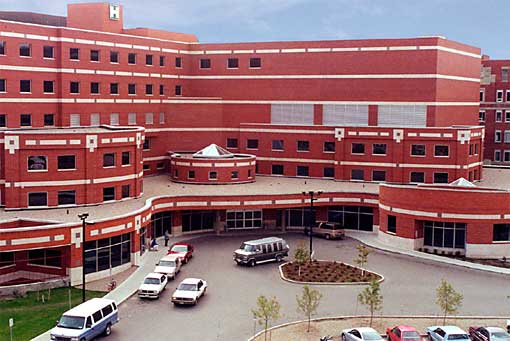| 제목 | [DAIKIN] HEALTHCARE - Regina General Hospital | 작성일 | 16-06-16 13:55 |
| 글쓴이 | 최고관리자 | 조회수 | 5,876 |
본문
CASE STUDY
Healthcare Facility
Name
Regina General Hospital
Location
Regina, Saskatchewan CA
Facility Size
Emergency, MRI, Energy Center and nurses' residence
Issue
A major expansion and renovation of the hospital added significant new facilities
Solution
Daikin 1,350 ton dual compressor centrifugal chillers in series counterflow
Regina General Hospital meets energy savings goal with Daikin series counterflow dual centrifugal chillers
Officials at Regina General Hospital look well into the future to provide progressive and innovative care for the people of southern Saskatchewan. A recent major expansion and renovation of the hospital added significant new facilities, including an emergency ward, MRI and Energy Center, tunnel connecting buildings, and nurses' residence. This same progressive approach to health care service applies to the hospital's mechanical system, too.
Faced with an aging chiller plant that cost too much to maintain and too much to operate, hospital officials specified that new equipment serve the facility cost-effectively and meet their requirements for the next 25 to 50 years. A cost analysis of several different systems provided the answer: two Daikin 1,350-ton dual compressor centrifugal chillers arranged in series counterflow. "We had been using natural gas absorption chillers installed in 1977," said Rick Pearce, chief engineer, Regina General Hospital, "but they had become too expensive to operate and time consuming to maintain. The price of natural gas alone had gone up 52 percent over the year prior to the project, which made the switch to electricity easier. When we learned that we could save 11.9 million dollars (Canadian) over the life cycle of the equipment—about $500,000 annually—it was an easy decision to make."
In addition to meeting the long-range goal in terms of life-cycle cost, Saskatchewan Health, the governing body of all health facilities in the province, instilled another requirement. According to the department's new policy, all chillers in its health system must use a refrigerant that is not scheduled for phase out under the terms of the Montreal Protocol. Daikin chillers use HFC-134a refrigerant, which has no ozone depletion potential or phase-out schedule.
Regina General Hospital is one of Regina's two major hospitals and is part of the Regina Qu'Appelle Health Region. The acute care facility and major referral center serves southern Saskatchewan with a variety of specialties, including cardiosciences, neurosciences and trauma care. Established over 100 years ago, Regina General's most recent renovation completed in 1998 positioned the facility to meet Saskatchewan's health care need for now and in the future.
Series counterflow arrangement is answer to requirement
With low life-cycle costs as a primary requirement, Shawn Lamb, engineer, Stantec Consulting, Regina, conducted a capital and operational cost analysis of bids submitted from several manufacturers.
"We made the final decision based on a 'Total Net Present Value Calculation' using 2006 dollars. This took into account the capital cost of the equipment and 25-year operating costs, assuming maintenance costs are equal," said Lamb. Most of the systems were designed as a parallel arrangement.
After calculating payback amounts over 25 years, it was apparent that the series counterflow arrangement of the chillers provided the lowest life cycle costs. "It's nice when it's that obvious," said Lamb.
Series counterflow chiller arrangements are more energy efficient than chillers arranged in parallel series because they allow for more efficient operation of each chiller. To achieve 44°F supply chilled water temperature at Regina General, each chiller needs only to produce a chilled water delta T (temperature differential) of 6°F to achieve the total 12°F required. Energy is reduced because each chiller produces only a portion of the delta T required. (See sidebar below: series counterflow chillers can cut energy costs 20%.)

Regina General Hospital's two Daikin 1,350-ton dual compressor centrifugal chillers arranged in series counterflow
Dual centrifugal chillers unload to five percent of full load capacity
In addition to the series counterflow arrangement, Daikin dual compressor centrifugal chillers are designed to provide exceptional part load efficiency. In addition, the chiller can unload smoothly to match the exact building load—down to five percent of the full load capacity without an inefficient hot gas bypass system.
While single compressor chillers are most efficient at or near 100 percent capacity, and often require hot gas bypass to unload, a dual compressor chiller is most efficient at 50 to 60 percent capacity and can easily unload much further. The dual centrifugal chillers utilize two compressors on a common refrigeration circuit, which is the reason for the part load efficiency gain.
"With the new chillers in place, it's not only a relief to get away from the high maintenance of the old chillers, it's also satisfying to know that we are keeping our energy costs as efficient as possible," said Pearce. "We're getting much more out of our HVAC system these days." With its new efficiencies, Regina General has a clean bill of health that will continue well into the future.
Series counterflow chillers can cut energy costs 20 percent
"Series counter flow chiller plants are one of the most energy-efficient, capital stingy, and environmentally responsible chiller installations available," said Daryl Showalter, director of chiller marketing at Daikin. "Although they shatter past paradigms, it's not a new concept. Designers have always been challenged to find effective ways to use multiple chillers in their chiller plant designs because they afford redundancy over single chiller plant designs. There are times when low supply water temperature and delta Ts (differential temperatures) make sense. Large chilled water plants, such as health care and institutional facilities, are excellent candidates. A series counter flow chiller plant is one of the best solutions."
Series counter flow chillers have condensers piped in series counter flow to the chilled water. This arrangement enhances chiller performance by "cascading" the chillers. Cascading the lift requirement for the chiller plant improves the design chiller efficiency by almost seven percent over a single chiller. Resulting savings can be more than 20 percent in chiller energy usage. The desired supply chilled water temperature at Regina General Hospital is 44°F with a water temperature differential of 12°F. The Daikin chillers have a relatively low internal pressure drop, with the evaporator side being 9.0 ft H2O and the condenser side at only 3.6 ft H2O. The low internal pressure drop makes the series counter-flow arrangement much more viable. On an overall system level, the primary evaporator loop pressure drop is 60 ft H2O while the primary condenser loop pressure drop is 55 ft H2O.
Large delta T chilled water systems not only reduce chiller water pump and pipe sizes for additional capital savings, but they can also reduce chilled water pump work, for additional operating cost savings. That's because the pump and pipe savings are connected to chilled water delta T—not supply water temperature.
| 이전글 | [DAIKIN] HEALTHCARE - TriStar-Skyline-Madison 2016-06-16 | ||
| 다음글 | [DAIKIN] HEALTHCARE - Whittier Clinic 2016-06-16 | ||






